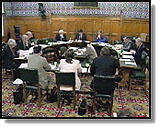

|
|
A thing of the past? Westminster MPs discussing matters Welsh |
Welsh Devolution
Briefing by Vaughan Roderick, Welsh Affairs Editor, BBC Wales
Part 2. Wales and Westminster
The relationship of the Assembly to Westminster and possible future conflicts
Labour's devolution plans emerged after a long policy-making process. The scheme, however, was strikingly similar to 1979 but with some key-changes designed to ensure Labour unity and to eliminate negative perceptions of the 1970's plan.
Even though the similarities between the schemes presented to the Welsh electorate in 1979 and 1997 are striking, itís on the differences that the referendum result may hinge.
In 1979 the government proposed an Assembly without law-making or tax powers. But what the Bill would have given the people of Wales was a form of "horizontal devolution" under which distinction would be made between "primary"and "secondary" legislation at Westminster. In the first instance the Welsh Assembly would have responsibilities for:
- Housing
- Education
- Health
- Planning
- Environment
- Welsh Development Agency - to be devolved
- The Assembly would have had the power to appoint nominated bodies.
- Assembly empowered to do anything within its powers to aid museums, galleries, libraries, the Welsh language, arts, crafts, sport and other cultural and recreational activities.
The 1997 proposals are virtually identical except that the range of areas of responsibility has been increased in line with the powers transferred to the Welsh office by the Conservative Government. The White Paper also makes vague noises regarding the Assemblyís relationship with Europe but is vague on detail.
The main differences between the 1979 and 1997 proposals lie in the Assemblyís composition.
The 1979 plan was for a 72-member Assembly elected by the first past the post system. In 1997 the Government is proposing a 60-member body, with 40 members elected by first past the post and 20 top-up seats to ensure proportionality between the parties. This change is designed to meet one of the "NO" campaignís main charges in 1979, that the Assembly would be dominated by the Labour Party. Under the proposed voting system, it is conceivable that Labour would have no overall majority in the Assembly.
The 1997 plan also includes provision for regional committees - a move planned to counter the 1979 charge that the Assembly would be dominated by South East Wales.
While the Assembly would have a committee structure, it would also have a "cabinet" and "prime minister" of sorts. Its "cabinet" (the executive committee) would consist of the chairmen of all the subject committees - each of whom would be a member of the governing party. Its "Prime Minister" would be the Assembly leader - the chairman of the executive committee.
The Assembly would be charged with reforming the quangos system in Wales but Labourís promised "bonfire of the Quangos " seems to have been delayed until the Assembly itself studies the system.
- Introduction
-
1. 1979 and all that
A comparison of the 1979 and 1997 proposals and campaigns -
2. Wales and Westminster
The relationship of the Assembly to Westminster and possible future conflicts -
3. At what cost?
The cost of an Assembly -
4. You decide
The Referendum -
5. Yeah or Nay
The two campaigns -
6. What if?
Post-referendum scenarios


